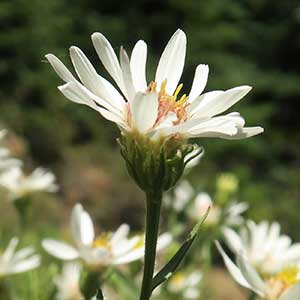Eucephalus paucicapitatus
Eucephalus vialis
Olympic mountain-aster
wayside aster
ascending to erect, pilose or glandular-pubescent.
erect, pilose to glandular-pubescent.
mid and distal blades elliptic to elliptic-oblong, 2–4 cm × 4–13 mm, sparsely scabrous to stipitate-glandular abaxially, moderately stipitate-glandular adaxially.
middle and distal cauline blades lanceolate-elliptic, 5–9 cm × 15–30 mm, abaxial faces usually glabrous, sometimes sparsely pubescent, adaxial faces glandular-pubescent.
stipitate-glandular.
stipitate-glandular.
turbinate-obconic, 7–9 mm.
turbinate, 8–10 mm.
0.
in 2–3 series (whitish), lance-linear (unequal), apices acute, abaxial faces stipitate-glandular.
in 3–6 series (sometimes reddish at margins and apices), linear to linear-oblong (strongly unequal), apices acute to acuminate, abaxial faces stipitate-glandular.
usually 2–4 in racemiform to corymbiform arrays, somtimes borne singly.
5–50(–120) in racemiform to paniculiform arrays.
obconic, pilose;
pappus bristles in 2 series, ± barbellate.
pilose;
pappus bristles in 2 series, smooth or ± barbellate.
7–13(–21), white.
Eucephalus paucicapitatus
Eucephalus vialis
Eucephalus paucicapitatus is found on Vancouver Island, where it is very uncommon, and the Olympic Peninsula. It is closely related to E. gormanii.
(Discussion copyrighted by Flora of North America; reprinted with permission.)
Of conservation concern.
Eucephalus vialis is only known from Lane and Douglas counties. It is considered threatened. It is in the Center for Plant Conservation’s National Collection of Endangered Plants.
(Discussion copyrighted by Flora of North America; reprinted with permission.)


